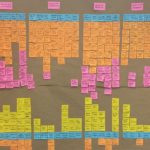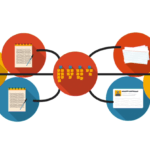Experience Mapping
An Experience Map maps out a chronological order of actions and highlights specific pain points along the way. This is a great way to turn your site observations into a visual story; it can also be used to set goals and gather information for personas.
This should be a team activity involving all members of the design team who have conducted site visits. This is a time for each team member to share their experiences, where all members can discuss how their site visits aligned or differed. Each of the team members will put the information they gathered onto sticky notes and arrange them in groupings that depict each of the stages in the user’s tasks. Moving through the tasks, you’ll be able to see the pain points that arise at specific stages of the stakeholder’s process.
Detailed Steps:
- Put a large sheet of paper on the wall so you can move the map later
- Everyone puts sticky notes on the wall chronologically (from left to right) according to when the observation occurred in the stakeholder’s process.
- Group similar observations into columns
- Each team member should call out what they’re putting up, so others can post similar observations at the same time
- You can combine similar ones
- Whatever disagreements arise will highlight important facets of the user experience
- It is best to use the following colors for your sticky notes:
- Yellow – Quotes and Observations: This will be the vast majority of your stickies. Quotes provide much richer context here.
- Green – Tasks: Above each column of observations, post a green sticky as a heading that denotes what user task these observations fit under.
- Blue – Activities: Above groups of tasks, place blue stickies to denote what activities the user tasks are trying to accomplish.
- Orange – Design Ideas: These are impermanent ways to get out any design ideas you may have along the way. It’s better to stick these onto the board than to forget them or (even worse) get them stuck in your head!
- Pink – Questions: Use pink stickies to post any questions that may arise as part of this journey.
Tips + Tricks
- It’s best to create Experience Maps when the data is still fresh. Consider doing site visits in the morning and Experience Maps that afternoon.
- Everyone on the team should be involved.
- It may be helpful for each team member to put their initials on sticky notes for future reference.



 Previous Post
Previous Post